Java testing frameworks play a pivotal role in ensuring Java applications’ reliability, efficiency, and overall quality. In the dynamic landscape of software development, choosing the proper testing framework can significantly impact a project’s success.
This comprehensive guide aims to explore and highlight the top 8 Java testing frameworks that stand out in 2023, showcasing their features, strengths, and how they empower developers to ensure robust, error-free applications. Let’s get cracking!
What are Java Testing Frameworks?
Java testing frameworks serve as essential tools for developers, testers, and QA engineers engaged in test automation. These frameworks simplify the creation and execution of tests by establishing a structured set of rules, guidelines, and requirements.
Comprising various features like assertions, mocking, data management, and test runners, these frameworks contribute to enhanced efficiency and productivity in the testing process.
Going beyond mere efficiency in testing, a Java testing framework provides a meticulously guided blueprint for the entire testing process, covering aspects like test data information, scripting guidelines, test results, repositories, and more.
According to the PYPL Index, Java holds the second spot as the most widely used programming language globally. Additionally, there are currently 45 billion active Java Virtual Machines worldwide. Given the recent surge in the popularity of Java testing frameworks, this article will delve into the top choices available.

What are Java testing frameworks?
The 8 Best Java Testing Frameworks in 2023
| Frameworks | Key features | Advantages | Disadvantages |
| Selenium | Browser automation supports multiple programming languages and cross-browser testing. | Cross-browser testing, wide community support, supports multiple programming languages. | – Steeper learning curve
– Slower execution compared to unit testing frameworks Java. |
| JUnit | Annotations for test methods, assertions, and parameterized tests. | Lightweight, simple annotations, good integration with IDEs. | Limited support for parameterized tests, lacks some advanced features. |
| TestNG | Annotations for test configuration, parallel execution, and data-driven testing. | Parallel execution, flexible test configuration, supports data-driven testing. | Limited community support, less popular than JUnit. |
| Cucumber | Descriptive feature files, step definitions, and scenario outline. | Easy-to-read scenarios, collaboration between stakeholders, reusability. | Requires a learning curve for Gherkin syntax, maybe too verbos. |
| Serenity | Rich reporting, integration with Selenium, and easy-to-read syntax. | Comprehensive reports, easy integration with Selenium, clear reporting. | Learning curve for advanced features, potential resource overhead. |
| Mockito | Creating mock objects, verifying interactions, stubbing. | Simplifies unit testing frameworks for Java, easy to use, and reduces test code duplication. | Limited to mocking, not suited for end-to-end testing. |
| JBehave | Executable stories, scenarios, step definitions. | Clear, expressive scenarios, easy to understand, encourage collaboration. | The learning curve for creating executable stories. |
Selenium
Selenium, an open-source testing framework, is employed to conduct tests across various browser versions and operating systems. Despite being a library, it merits inclusion in the list in light of its widespread usage as one of the most commonly employed Java testing tools. Through the utilization of Selenium, testers can automate repetitive test cases, thereby accelerating release cycles.

Selenium Java testing frameworks
Key features
- Can be used as a data-driven, keyword-driven, and hybrid testing framework
- Execute in multiple operating systems: Windows, Android, iOS, macOS, and more
- Support browser automation, and cross-browser testing
Advantages
- Support numerous programming languages like C#, Java, Python, JavaScript, PHP, Ruby, and more.
- Integrate with multiple popular automated testing Java frameworks like JUnit, TestNG, etc.
- Easy to access, to learn, and to create tests
- Allow parallel test implementation, accelerating efficiency and decreasing testing time.
- Highly scalable by leveraging cloud-based automation grids
Disadvantages
- Scarcity of built-in reporting facility
- Only supports web application testing
- Time-consuming for test case creation
When to use Selenium?
The developers can go for Selenium for the following requirements:
- Cross-browser testing
- Browser automation testing
JUnit
As the open-source foundation testing framework on the Java Virtual Machine, JUnit remains popular today thanks to its efficiency, fast results, and simplicity.
Rooted in the test-driven development (TDD) approach, which aligns with the “test a little, code a little” philosophy, JUnit aims to elevate code stability, enhance productivity, and augment quality. It facilitates the early detection of bugs and issues in the developmental stages.

Junit Java testing frameworks
Key features
- Support various IDEs such as IntelliJ IDEA, VSCode, etc.
- Conduct unit testing with high-efficiency
- Provide assertions and annotations to simplify the test case writing procedure
- The ability to maintain backward compatibility
- Supports writing self-verifying tests
Advantages
- Improves productivity and stability of code
- A simplified framework to deploy automated test scenarios
- Allows retesting of all available scenarios
Disadvantages
- No support for dependency testing and GUI testing
- Not efficient for handling a considerable number of test suites
When to use JUnit?
The developers or QA Analysts can go for JUnit for:
- Unit testing
- Regression testing
TestNG
Inspired by the two prominent frameworks – JUnit and NUnit, TestNG is a more adaptable open-source test automation framework that offers some additional superior functionalities.
The “NG” in TestNG stands for “Next Generation”, symbolizing its evolution to address certain limitations observed in the frameworks that served as its inspiration. Renowned as one of the top Java test frameworks, TestNG stands out for its advanced capabilities, particularly in situations requiring the execution of a substantial number of test cases.
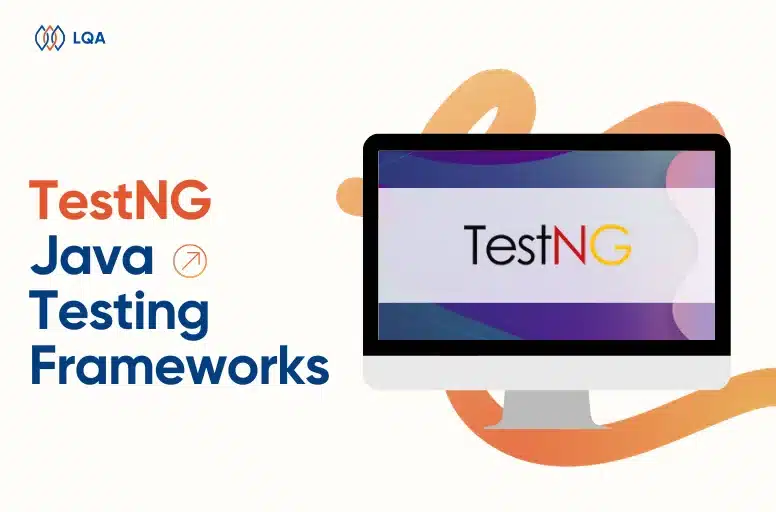
TestNG Java testing frameworks
Key features
- Provides support for parallel testing
- Provides XML and HTML reports and even helps generate custom reports
- TestNG’s open API enables users to create custom extensions
- Data-driven testing support
- Multi-threaded code safe tests for your code
- Sequence, group, and parameterize
Advantages
- Provides various after/before annotations for setup and cleanup choices
- Offers flexible API plugin and runtime configuration
- Enables dependent test methods, multiple threaded testing, and data-driven testing
Disadvantages
- Setup and installation can be time-consuming
- Not recommended if you don’t have a priority list for test cases
- Finding experienced experts can be difficult
When to use TestNG?
The developers or QA Analysts can go for TestNG for:
- Unit testing
- Functional testing
- End-to-end testing
- Integration testing
Cucumber
Cucumber functions as an automation testing framework designed for behavior-driven development (BDD), enabling testers to create human-readable acceptance tests that articulate a system’s behavior.
Utilizing Gherkin, a natural language parser, Cucumber facilitates the composition of plain-text functional scripts for enhanced clarity and comprehension.
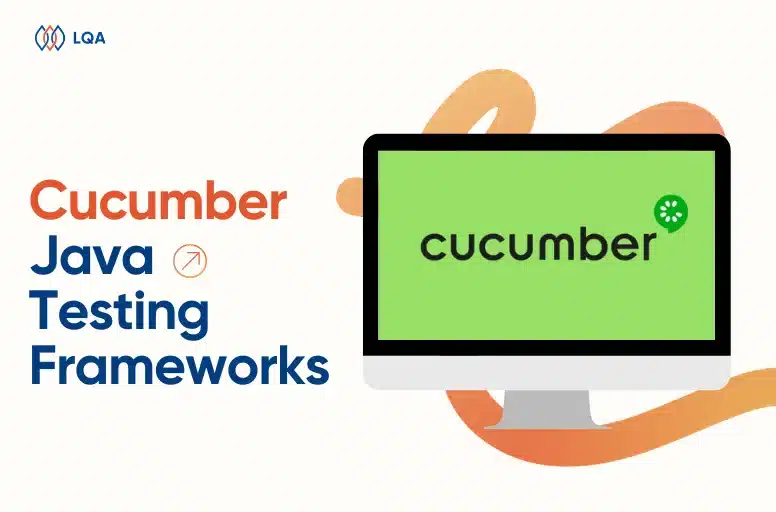
Cucumber Java testing frameworks
Key features
- Consolidates the documentation along with the specifications
- Delivers a single report document
- The specification gets updated automatically
- Code reusability
Advantages
- Better readability
- Faster development time thanks to code reusability
- User-friendly interface to reduce the technical entry barrier
- Example tables can be used to automate test scenarios
Disadvantages
- Complexity arising from the combination with Gherkin
- Possible elaborations due to the given-when-then format
When to use Cucumber?
The developers or QA Analysts can go for Cucumber for:
- Automated acceptance tests
- Agile project
Serenity
Another automated testing framework for behavior-driven development (BDD) – Serenity stands out as a widely favored Java test framework, empowering Java developers to craft tests that are well-organized and easily manageable.
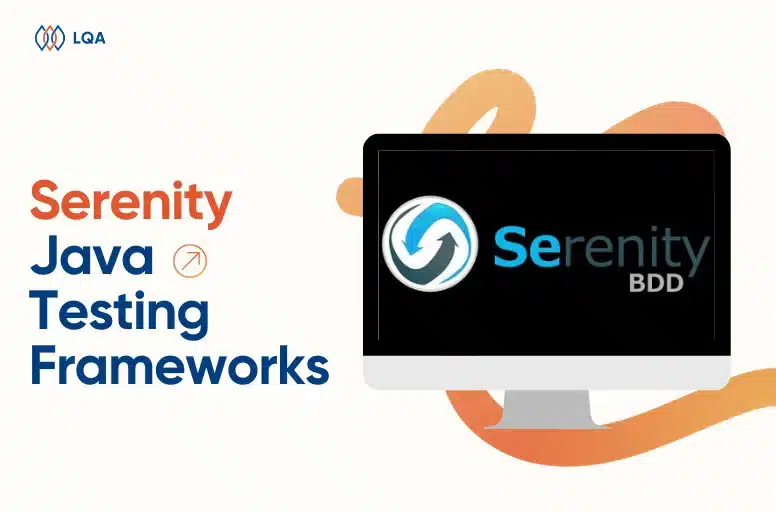
Serenity Java testing frameworks
Key features
- Produces comprehensive documentation
- Provides reports for project progress, test progress, results, and more
- Supports multiple automated acceptance testing solutions
- Create descriptive reports with a business-readable format for each test
Advantages
- Easily integrated with various other frameworks like Selenium WebDriver, JBehave, JUnit, and Appium
- Cleaner and more structured code creation
- Highly effective for behavior-driven testing
- Easy understanding and implementation by using Domain-specific language (DSL)
- Rich built-in support for web testing with Selenium
- Highly readable, manageable, and scalable automation testing with the Screenplay pattern
Disadvantages
- Requires constant communication
- Creating feature files can be time-consuming
When to use Serenity BDD?
The developers or QA Analysts can go for Serenity BDD for:
- Automated Acceptance Testing in a behavioral-driven development
- Regression Testing
Mockito
Mockito is a popular, open-source Java-based behavior-driven testing framework. Mocking is a common technique in unit testing, as it simulates the behavior of dependencies to isolate the test to a specific unit.
The key advantage of employing Mockito is the absence of a need to manually create mock objects, as the framework generates them automatically. Mocks are generated through the use of annotations.
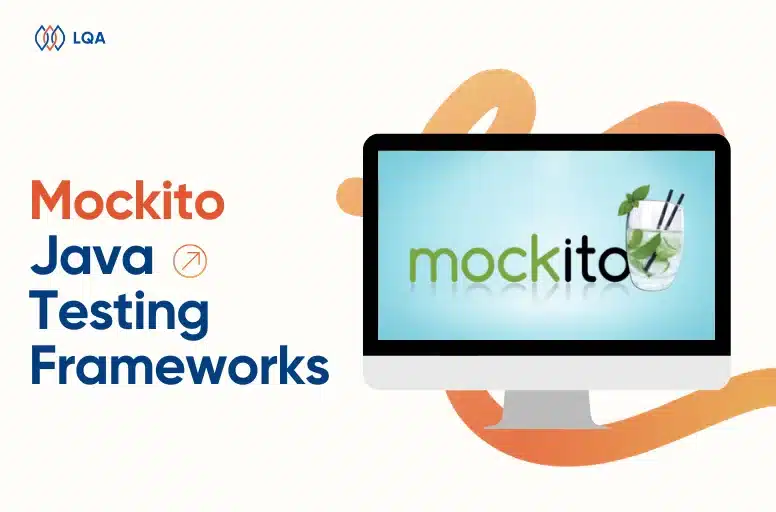
Mockito Java testing frameworks
Key features
- Mocks concrete classes and interfaces, and can be constructed using annotations
- Verification support i.e exact-number-of-times and at-least-once
- Argument matchers for flexible verification with an option to create custom matchers as well
- Clean verification errors support
Advantages
- Easily create mock objects using annotations like @Mock.
- Cost-effective and ideal for creating POC (proof of concept).
- Better void method handling compared to other frameworks like EasyMock
- Safe refactoring
- Simple setup
- No need for manual writing of mock objects
Disadvantages
- No support for local variable mocking
- No support for private and static methods
When to use Mockito?
The developers or QA Analysts can go for Mockito for unit testing
Spock
Built upon Java and Groovy, Spock is a framework designed for behavior-driven testing and specification, tailored for unit and integration testing. Spock tests can be authored for any programming language compatible with the Java Virtual Machine (JVM).
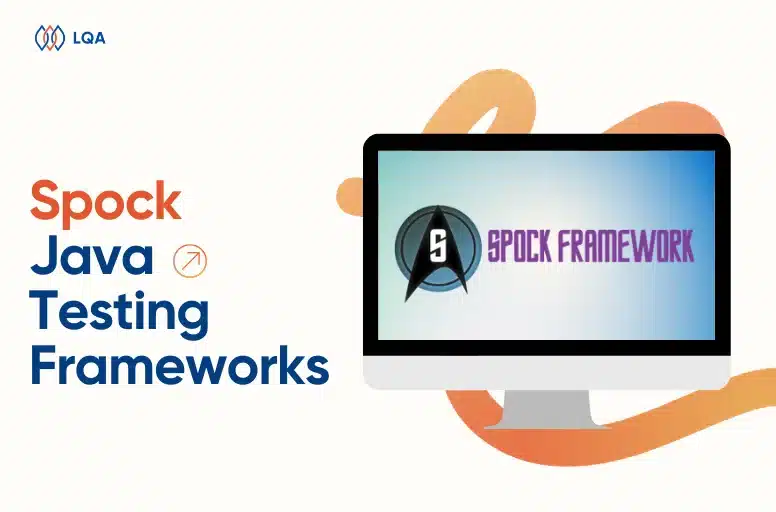
Spock Java testing frameworks
Key features
- Support for data-driven testing
- Comprehensive documentation
- Access to in-built mocking and stubbing
Advantages
- Excellent code readability
- Strong and simple Domain-Specific Language (DSL)
- Compatible with most Java IDEs and build tools
- User-friendly interface
- Shorter and crispier parameterization
Disadvantages
- Requires a basic understanding of Groovy
When to use Spock?
The developers or QA Analysts can go for Spock for:
- API testing
- Data-driven testing
JBehave
JBehave is one of the automated testing frameworks Java, often employed in conjunction with Selenium drivers, and is geared towards supporting Behavior-driven development (BDD). It ranks among the top Java testing frameworks specifically utilized for BDD testing, commonly paired with Selenium WebDriver for Java.
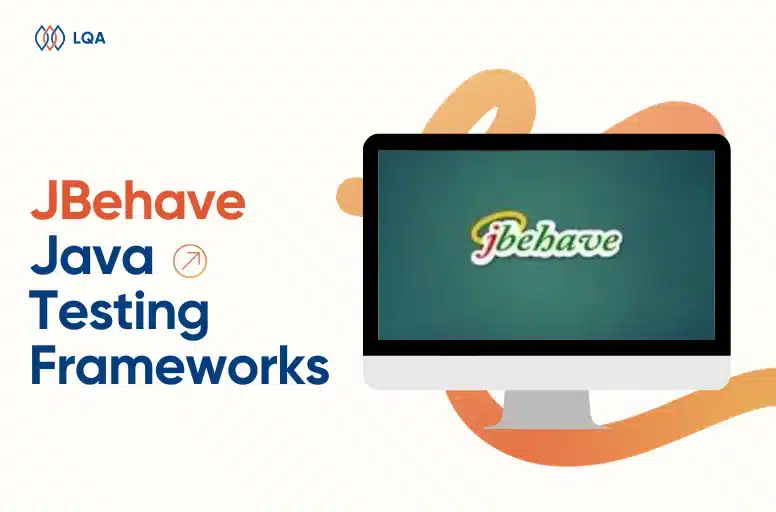
Jbehave Java testing frameworks
Key features
- Allows user stories to be executed concurrently and grouped as classpath or URL-based resources
- Generates pending steps automatically
- Documents user stories with customizable meta information
- Annotation-based configuration and Steps class specifications
- Provides a comprehensive reporting functionality
Advantages
- Powerful reporting mechanism
- Simplicity and ease of use
- Easy Java integration testing frameworks with other annotation unit testing frameworks such as JUnit
- Provides extensive documentation (XML, HTML, or Text format)
- Supports JUnit out of the box
Disadvantages
- Requires a dedicated team to manage test stories
- Relies on effective communication among members as it is key to the success of BDD testing
- Supports stories only, not test features
When to use JBehave?
The developers or QA Analysts can go for JBehave for:
- Acceptance testing
- Tests created in a business domain language
The Advantages of Using Java Automated Testing Frameworks
Why is using testing framework Java necessary for high-quality software development? Let’s discover the numerous benefits that the Java testing framework brings to the table.
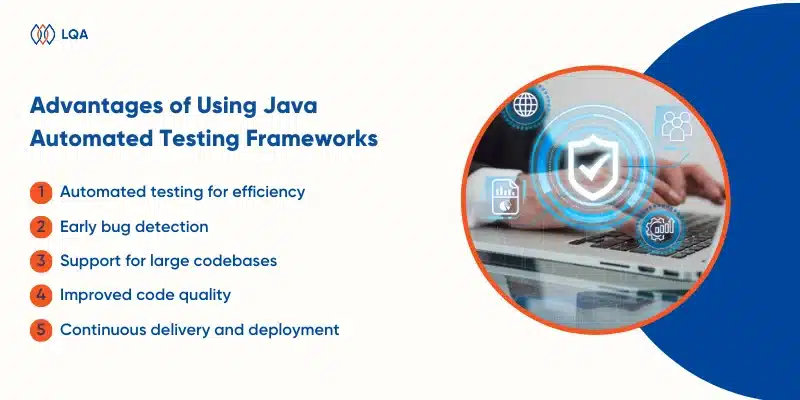
Java testing framework advantages
- Automated testing for efficiency: Java automated testing frameworks allow for the automation of test execution, saving time and effort compared to manual testing. Automated tests can be run consistently and repeatedly, ensuring thorough testing without the need for manual intervention.
- Early bug detection: By integrating seamlessly with continuous integration tools, Java automated testing frameworks enable the early detection of bugs as code changes are introduced. This facilitates a proactive approach to bug fixing and contributes to overall software quality.
- Support for large codebases: Java testing frameworks are designed to handle large and complex codebases, providing the scalability needed as projects grow in size and complexity.
- Improved code quality: Java testing frameworks provide a safety net during code refactoring by quickly identifying any regressions or issues introduced by changes. This promotes a culture of code improvement and enhances the overall quality of the codebase.
- Continuous delivery and deployment: Java automated testing frameworks are crucial for continuous integration and continuous deployment (CI/CD) pipelines. It ensures that only thoroughly tested code is deployed to production, reducing the risk of introducing bugs in the live environment.
The advantages of utilizing Java testing frameworks are clear, yet it’s necessary to consider certain factors when selecting the appropriate tool for your project.
Things To Consider When Choosing Testing Tools or Frameworks in Java
Determining the optimal Java automation testing framework for your project is not a one-size-fits-all scenario. To make an informed decision, it’s crucial to carefully assess the specific advantages and drawbacks of each framework in relation to your project requirements. Let’s break down some important things to consider when picking a Java testing framework:
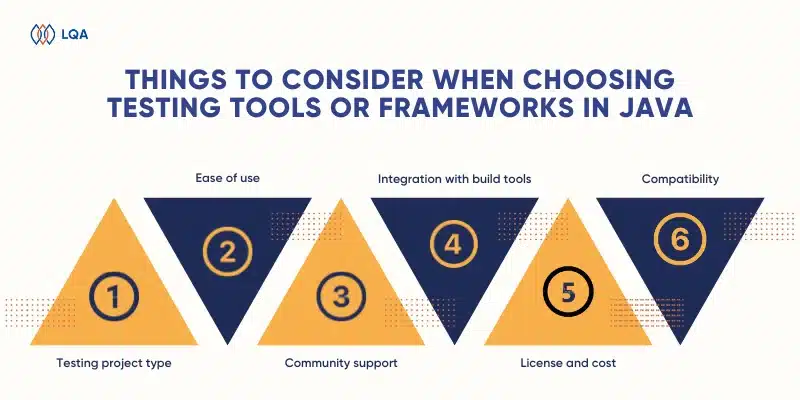
How to choose Java testing frameworks
- Testing project type: Define the types of testing you need to perform (unit testing, integration testing, functional testing, etc.). Different tools specialize in different types of testing.
- Ease of use: Choose tools that are easy to set up and access. A user-friendly interface and clear documentation can significantly reduce the need for extensive training for your team.
- Community support: Look for tools with an active community. A strong community ensures ongoing support, updates, and a wealth of resources such as forums, tutorials, and plugins.
- Integration with build tools: Ensure that the testing tools integrate seamlessly with your build tools (e.g., Maven, Gradle). This helps automate the testing process and ensures that tests are run consistently.
- License and cost: Consider the licensing and cost implications of the testing tools. Some tools are open source, while others may require a commercial license.
- Compatibility: Check the compatibility of the testing tools with your development environment and other tools in your tech stack. Ensure that the tools work well with the versions of Java and other libraries you are using.
How Can LQA Enable You to Make the Most of Java Testing Frameworks?
Utilizing Java unit testing frameworks proves highly advantageous thanks to their comprehensive features, guidelines, and adherence to structural rules. These frameworks play a pivotal role in enhancing project efficiency and performance.
No one can deny the benefits the Java testing frameworks. However, choosing the proper Java testing frameworks requires a lot of careful considerations, factors and expertise. As a leading destination for software testing with technicians and professionals of more than 7 years of experience, Lotus Quality Assurance is ready to provide assistance in testing applications on browser platforms and real devices.
LQA’s comprehensive and automated testing framework can help businesses reduce the time and effort associated with traditional approaches. It seamlessly integrates with diverse development teams and projects, maintaining high consistency levels across structural processes, including design paradigms, communication, and automation.
Moreover, LQA proudly holds prestigious industry awards and certifications, attesting to our commitment to excellence in software testing. These acknowledgments underscore the reliability and quality of our services, reinforcing our position as a trusted provider in the field.
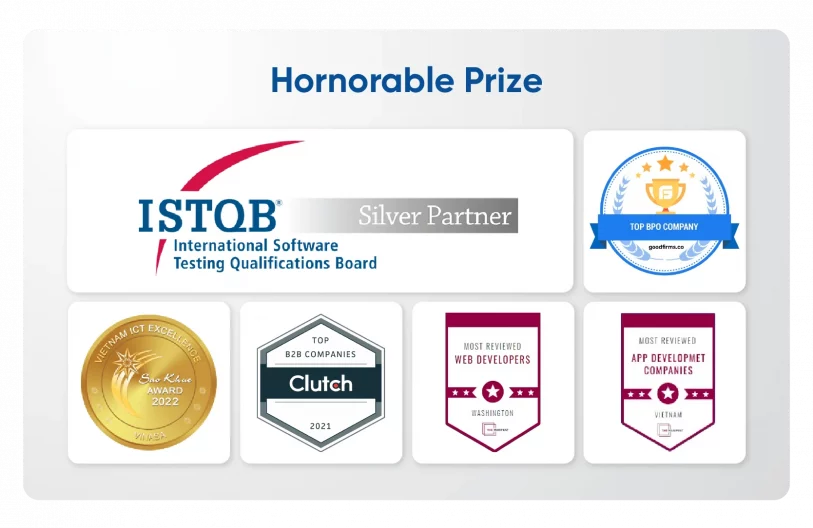
LQA software quality assurance awards
Contact us today for top-notch consultation and support in the realms of software testing and automation.
Frequently Asked Questions about Java Testing Frameworks
What is testing framework for Java?
Java testing frameworks streamline the testing process by automating it, enabling developers to write and execute tests for their code and analyze the outcomes. These frameworks establish a blueprint for the testing cycle, defining the structure and strategy of the tests, including guidelines for test data, scripting, test results, and repositories.
What are the differences between Java testing frameworks vs libraries?
Java testing frameworks, such as JUnit and TestNG, provide comprehensive structures for organizing and executing tests. They define conventions for test design, control the flow of test execution, and offer features like parameterized tests and test suites. In contrast, testing libraries, like AssertJ and Mockito, focus on specific functionalities, such as assertion methods and utilities, without imposing a specific test structure. Libraries offer more flexibility, allowing developers to make decisions about test organization and execution flow based on their specific needs.
Which Java framework is commonly used for running Java unit tests?
JUnit is a widely adopted testing framework for running Java unit tests. It provides annotations for test methods, supports assertions for result verification, and offers various runners for executing tests. JUnit is well-integrated with popular IDEs and build tools, making it a standard choice for developers. Another notable framework is TestNG, which also enjoys widespread use. TestNG provides additional features like parallel test execution, data-driven testing, and flexible configuration options, making it suitable for various testing scenarios. The choice between JUnit and TestNG often depends on project requirements and developer preferences.
Final Thoughts About Java Testing Frameworks
Java testing frameworks provide well-defined guidelines, regulations, and robust functionalities that can significantly boost the effectiveness and efficiency of software development projects. The selection of an appropriate Java testing framework holds paramount importance in ensuring the success of the software development lifecycle.
This article delves into the examination of the 8 most popular and innovative Java testing frameworks favored by both developers and testers. Through our comprehensive Java testing frameworks comparison and analysis, it becomes evident that each framework possesses distinctive attributes, accompanied by its own set of advantages and disadvantages. Ultimately, the choice among them hinges on the specific requirements of your project and the testing type for your software applications.
The collaboration of a proficient Java testing framework with LQA’s robust software testing solutions and professional experts can streamline your software development efforts and elevate the overall quality of your software. Whether your focus is on cost management, accelerating time-to-market, or advancing quality assurance procedures, LQA checks all the relevant boxes.
Feel free to reach out to us today for expert consultation and assistance in the realms of software testing and automation.
- Website: https://www.lotus-qa.com/
- Tel: (+84) 24-6660-7474
- Fanpage: https://www.facebook.com/LotusQualityAssurance




